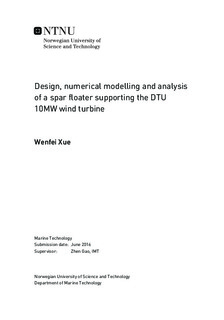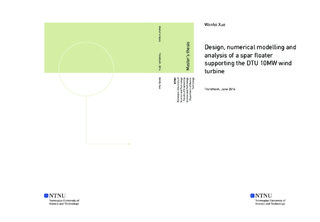| dc.description.abstract | Nowadays, wind energy is one of the most promising, sustainable and clean energy solutions for the future. The wind industry in Europe experiences a very fast development these years, moving from onshore to offshore in shallow water and then in deep water. A floating wind turbine is an offshore wind turbine mounted on a floating structure that allows the turbine to generate electricity in water depths where bottom-fixed towers are not accessible.
However, the offshore wind energy still has its shortcoming, i.e. the high cost. The most effective way to reduce the cost of energy is to use a larger wind turbine, which can absorb more wind power. So a new design of offshore wind turbine need to be considered.
In this thesis, a new spar-buoy concept was developed based on the OC3-Hywind concept which developed by National Renewable Energy Laboratory (NREL), to support the DTU 10MW reference wind turbine. An initial design is performed by upscaling of an existing 5MW spar platform design, then checked against buoyancy, stability, hydrodynamic and strength criteria. In addition, a spread catenary mooring system has been designed for the spar concept.
Then the SIMO-RIFLEX-AeroDyn model is established include viscous drag elements. It is found that the blade pitch controller can excite large platform resonant motion at above rated wind speeds during turbulent wind test, which could be possibly reduced by changing the PI gains of the controller.
Finally, time domain coupled dynamic analysis of the spar floating wind turbine is performed by using the SIMO-RIFLEX-AeroDyn code. Characteristic responses of the spar floating wind turbine are studied and compared to other two floating wind turbine concepts. It is found that spar has the largest surge oscillations among three concepts, yet the semi has largest pitch mean value and standard deviation than others. Due to the taut mooring system, all the motions for the TLP is much smaller as compared to the spar and the semi. | |

